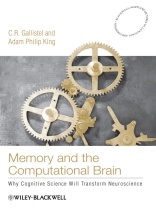Memory and the Computational Brain offers a provocative
argument that goes to the heart of neuroscience, proposing that the
field can and should benefit from the recent advances of cognitive
science and the development of information theory over the course
of the last several decades.
* A provocative argument that impacts across the fields of
linguistics, cognitive science, and neuroscience, suggesting new
perspectives on learning mechanisms in the brain
* Proposes that the field of neuroscience can and should benefit
from the recent advances of cognitive science and the development
of information theory
* Suggests that the architecture of the brain is structured
precisely for learning and for memory, and integrates the concept
of an addressable read/write memory mechanism into the foundations
of neuroscience
* Based on lectures in the prestigious Blackwell-Maryland
Lectures in Language and Cognition, and now significantly reworked
and expanded to make it ideal for students and faculty
argument that goes to the heart of neuroscience, proposing that the
field can and should benefit from the recent advances of cognitive
science and the development of information theory over the course
of the last several decades.
* A provocative argument that impacts across the fields of
linguistics, cognitive science, and neuroscience, suggesting new
perspectives on learning mechanisms in the brain
* Proposes that the field of neuroscience can and should benefit
from the recent advances of cognitive science and the development
of information theory
* Suggests that the architecture of the brain is structured
precisely for learning and for memory, and integrates the concept
of an addressable read/write memory mechanism into the foundations
of neuroscience
* Based on lectures in the prestigious Blackwell-Maryland
Lectures in Language and Cognition, and now significantly reworked
and expanded to make it ideal for students and faculty
Table of Content
Preface.1. Information.
Shannon’s Theory of Communication.
Measuring Information.
Efficient Coding.
Information and the Brain.
Digital and Analog Signals.
Appendix: The Information Content of Rare Versus Common Events and Signals.
2. Bayesian Updating.
Bayes’ Theorem and Our Intuitions About Evidence.
Using Bayes’ Rule.
Summary.
3. Functions.
Functions of One Argument.
Composition and Decomposition of Functions.
Functions of More than One Argument.
The Limits to Functional Decomposition.
Functions Can Map to Multi-Part Outputs.
Mapping to Multiple-Element Outputs Does Not Increase Expressive Power.
Defining Particular Functions.
Summary: Physical/Neurobiological Implications of Facts about Functions.
4. Representations.
Some Simple Examples.
Notation.
The Algebraic Representation of Geometry.
5. Symbols.
Physical Properties of Good Symbols.
Symbol Taxonomy.
Summary.
6. Procedures.
Algorithms.
Procedures, Computation, and Symbols.
Coding and Procedures.
Two Senses of Knowing.
A Geometric Example.
7. Computation.
Formalizing Procedures.
The Turing Machine.
Turing Machine for the Successor Function.
Turing Machines for f is _even
Turing Machines for f+
Minimal Memory Structure.
General Purpose Computer.
Summary.
8. Architectures.
One-Dimensional Look-Up Tables (If-Then Implementation).
Adding State Memory: Finite-State Machines.
Adding Register Memory.
Summary.
9. Data Structures.
Finding Information in Memory.
An Illustrative Example.
Procedures and the Coding of Data Structures.
The Structure of the Read-Only Biological Memory.
10. Computing with Neurons.
Transducers and Conductors.
Synapses and the Logic Gates.
The Slowness of It All.
The Time-Scale Problem.
Synaptic Plasticity.
Recurrent Loops in Which Activity Reverberates.
11. The Nature of Learning.
Learning As Rewiring.
Synaptic Plasticity and the Associative Theory of Learning.
Why Associations Are Not Symbols.
Distributed Coding.
Learning As the Extraction and Preservation of Useful Information.
Updating an Estimate of One’s Location.
12. Learning Time and Space.
Computational Accessibility.
Learning the Time of Day.
Learning Durations.
Episodic Memory.
13. The Modularity of Learning.
Example 1: Path Integration.
Example 2: Learning the Solar Ephemeris.
Example 3: ‘Associative’ Learning.
Summary.
14. Dead Reckoning in a Neural Network.
Reverberating Circuits as Read/Write Memory Mechanisms.
Implementing Combinatorial Operations by Table-Look-Up.
The Full Model.
The Ontogeny of the Connections?
How Realistic is the Model?
Lessons to be Drawn.
Summary.
15. Neural Models of Interval Timing.
Timing an Interval on First Encounter.
Dworkin’s Paradox.
Neurally Inspired Models.
The Deeper Problems.
16. The Molecular Basis of Memory.
The Need to Separate Theory of Memory from Theory of Learning.
The Coding Question.
A Cautionary Tale.
Why Not Synaptic Conductance?
A Molecular or Sub-Molecular Mechanism?
Bringing the Data to the Computational Machinery.
Is It Universal?
References.
Glossary.
Index.
About the author
C. R. Gallistel is Co-Director of the Rutgers Center forCognitive Science. He is one of the foremost psychologists working
on the foundations of cognitive neuroscience. His publications
include The Symbolic Foundations of Conditional Behavior
(2002), and The Organization of Learning (1990).
Adam Philip King is Assistant Professor of
Mathematics at Fairfield University.
Language English ● Format EPUB ● Pages 336 ● ISBN 9781444359763 ● File size 3.5 MB ● Publisher John Wiley & Sons ● Published 2011 ● Edition 1 ● Downloadable 24 months ● Currency EUR ● ID 2390023 ● Copy protection Adobe DRM
Requires a DRM capable ebook reader












